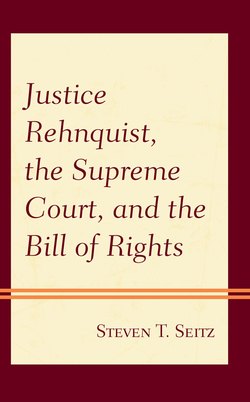Читать книгу Justice Rehnquist, the Supreme Court, and the Bill of Rights - Steven T. Seitz - Страница 16
Enumerating Rights
ОглавлениеMadison believed that the system of government engineered in the Constitution would protect individual rights and thus not need an enumerated Bill of Rights. He correctly reasoned that, if enumerated, the courts would only recognize these as rights and protect no other rights and privileges. He tried to check this tendency with the 9th Amendment, but the court’s subsequent decision-making confirmed Madison’s original concern. Madison identified few rights in the Constitution of 1787: habeas corpus, no post facto laws, no bills of attainder, trial by jury in criminal cases, and keeping the trial in the jurisdiction where the alleged crime occurred. The Constitution also included a “privileges and immunities clause” and a “full faith and credit clause” requiring each state to treat those from other states the same as it treats its own citizens and recognizing the legal documents of another state as legal in their own.[1]
Neither anti-Federalists nor many who controlled the state governments shared Madison’s faith in his political engineering. The anti-Federalists wanted a Bill of Rights, and state leaders often traded ratification of the Constitution for that promised Bill of Rights. Anti-Federalists remained unpersuaded by Madison’s enumeration argument. Many state leaders felt that the Constitution itself was not enough a check upon the central government and sought those checks in a Bill of Rights. After considerable debate, Congress sent twelve amendments to the states and they ratified ten, now known as the Bill of Rights. The hidden conflict between the Constitution and the Bill of Rights went much deeper than articles on a piece of paper, so deep that they had starkly opposed visions of the capacity of man and the public’s role in government.
Madison’s Constitution rested on a guarded view of humankind. The creature so capable of reason used it far less than desirable. Passion and self-interest motivated potential civic judgment. People of similar excitement used government, not for the public interest, but for the private interest. The civic person underlying the Bill of Rights was a reasonable decision-maker looking out for the best of human interests, knowing that securing the public interest was the best route to one’s own interests. The Constitutional view derived from long study of regime failures over the ages, while the Bill of Rights view derived from a simplistic vision of abstract freedom from government and the virtues of individual yeomen. The will or sense of the community stood for the Word of God. The community would be as one. Any minority had noise in their godly transmission line or else were in communication with a malevolent force.
The anti-Federalists, to unmask the obvious, were not all liberal freedom fighters but local elites who imposed conformity upon their minions while using the Bill of Rights to keep the federal government at a distance. They often represented the very passions and private interests that Madison sought to check and whom Hamilton called out in the first article in the Federalist Papers as big fish in little ponds who did not want to lose their power and status. These anti-Federalists typically viewed the Bill of Rights as not just another check on the powers of the central government, but a source of strict instruction from their states. These cross-purposes of Constitution and Bill of Rights would haunt judicial interpretation throughout the life of the court.
